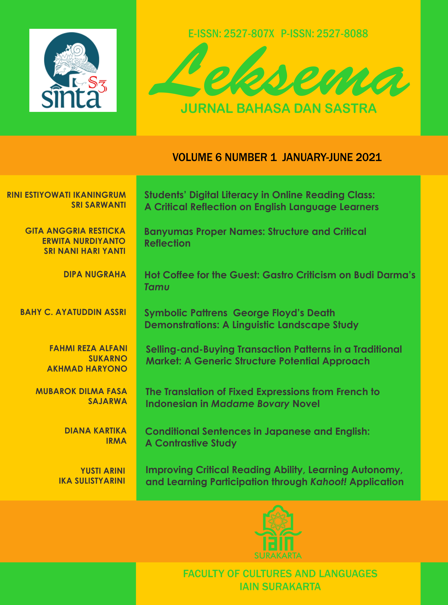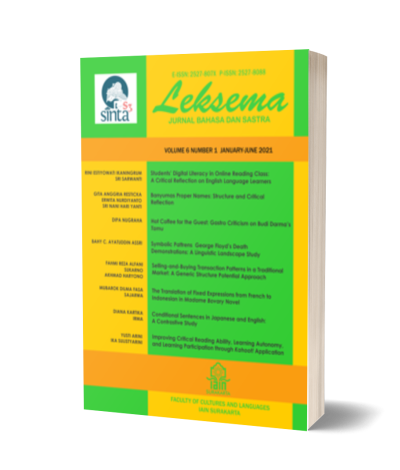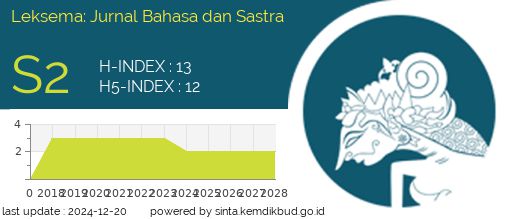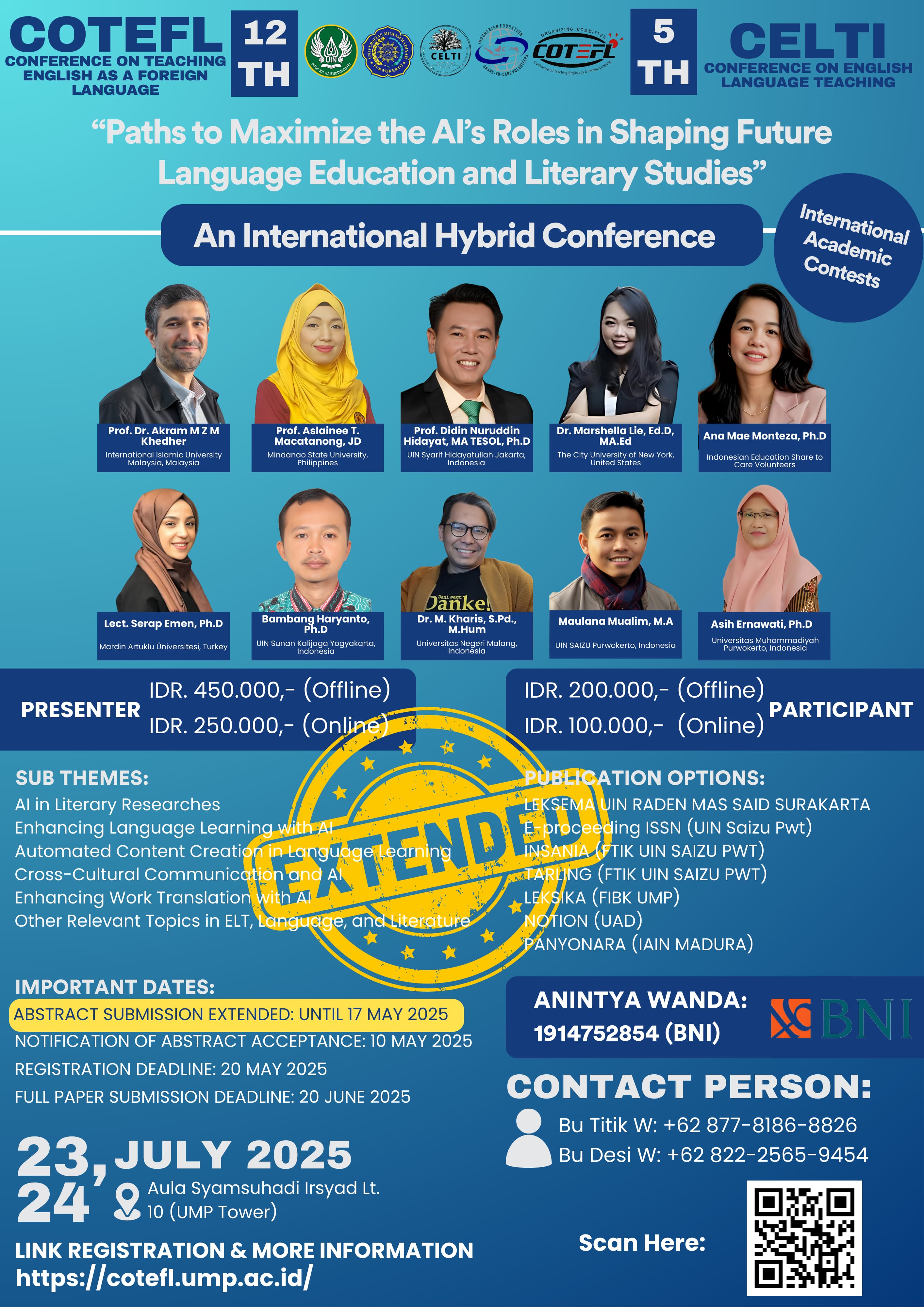SELLING-AND-BUYING TRANSACTION PATTERNS IN A TRADITIONAL MARKET: A GENERIC STRUCTURE POTENTIAL APPROACH
DOI:
https://doi.org/10.22515/ljbs.v6i1.3466Keywords:
communication, selling-and-buying transaction, generic structure potentialAbstract
This research aimed to investigate the patterns of selLing-and-buying transactions in a traditional market. The data sources of this research were the the sellers and the buyersin beef, chicken, fruit, grocery, and vegetable shopsof Pasar Waru, a traditional market, in Sidoarjo, Indonesia. The data were in the form of transactional conversations between the sellers and the buyers. Qualitative method was applied in this research by using the formula of generic structure potential theory proposed by Halliday & Hasan (1985) to describe the patterns of buying-and-selling transaction in the market. The result shows that generic structure elements in some shops at Pasar Waru comprises: greeting (G), sale initiation (SI), sale enquiry (SE), sale request (SR), sale compliance (SC), sale (S), purchase (P), purchase closure (PC), and finish (F). The grocery, beef, and chicken shop had a similar structure of G^SR^SC^S^P^PC, whereas the fruit shop showed its actual structure G^SI^SE^SR^SC^S^P^PC. Meanwhile, the vegetable shop had G^SI^SR^SC^S^P^PC structure. As a whole, the five shops produced generic potential structure [(G).^] [{ SR^ SC }^S^] P^PC.
Downloads
References
Ansary, Hasan & Esmat Babaii. 2005. “The Generic Integrity of Newspaper Editorials: A Systemic Functional Perspectiveâ€. RELC Journal36 (3): 271-295
Ary, Donald, Lucy Cheser Jacobs, Christine Sorensen & Ashgar Razavieh. 2013. Introduction to Research in Education. 9th Edition. Wadsworth: Cengage Learning
Astuti, Sri Puji. 2014. “Prinsip Kerjasama dalam Wacana Jual Beli di Pasar Tradisional Perumnas Tlogosari Semarangâ€. Jurnal Humanika, 20 (2), 67-73
Astuti, Sri Puji. 2018. “Tegur Sapa Penjual dan Pembeli di Pasar Tradisional Surya Kusuma Semarangâ€. Nusa, 13 (1): 147-155
Chaer, Abdul & LeonyAgustina. 2010. Sosiolinguistik Perkenalan Awal. Jakarta: Rineka Cipta
Halliday, MAK & Ruqaiya Hasan. 1985. Language, Context And Text: Aspects of Language In A Social-Semiotic Perspective. Victoria: Deakin University
Haryono, Akhmad. 2015. Etnografi Komunikasi: Konsep, Metode, dan ContohPenelitian Pola Komunikasi. Jember: UPT Penerbitan UNEJ
Hayati, Cut Ansi Faradiba. 2018. “The Analysis of Generic Structures and Copy Elements in Online Shop Video Advertisementsâ€. Passage, 6 (3): 37-56
Kyaw, Ae Mon & Xin Zhiying. 2019. “Exploring Generic Structure Potential of Selected Editorials in The Myanmar Timesâ€. Language Literacy: Journal of Linguistics, Literature and Language Teaching 13 (2): 139-149
Keraf, Gorys. 2004. Komposisi: Sebuah Pengantar Kemahiran Bahasa. Flores: Nusa Indah
Moleong, Lexy J. 2014. Metodologi Penelitian Kualitatif. Bandung: PT Remaja Rosdakarya
Nurmiah. 2014. “Implikatur Percakapan dalam Transaksi Jual Beli di Pasar Tradisional di Kota Paluâ€. Multilingual 13 (2):196-207
Putranto, Kristiawan Dwi, Sigit Ricahyono & Rosita Ambarwati. 2018. “Generic Structure Potential of Rolling Stone Magazine Cover February 9th, 2006 Edition: Critical Multimodal Discourse Analysisâ€. English Teaching Journal: A Journal of English Literature, Linguistics, and Education 6 (1): 25-31
Sudaryanto. 2015. Metode dan Aneka Teknik Analisis Bahasa: Pengantar Penelitian Kebudayaan secara Linguistis. Yogyakarta: Duta Wacana University Press
Wahyuni, Latifah Dwi & Nisa Afifah. 2014. “Perbandingan Kesantunan di Pasar Tradisional dan Pasar Modernâ€. Prosiding Prasasti: 78-83. Surakarta: Pascasarjana UnIversitas Negeri Sebelas Maret
Downloads
Published
Issue
Section
License
The copyright of the received article shall be assigned to the publisher of the journal. The intended copyright includes the right to publish the article in various forms (including reprints). The journal maintains the publishing rights to published articles.
In line with the license, the authors and users (readers or other researchers) are allowed to share and adapt the material only for non-commercial purposes. In addition, the material must be given appropriate credit, provided with a link to the license, and indicated if changes were made. If authors remix, transform or build upon the material, authors must distribute their contributions under the same license as the original.







